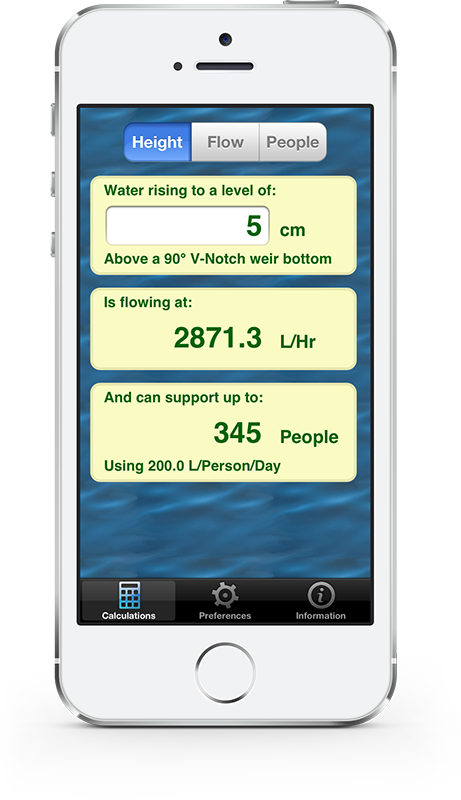NotchFlow
Measure water flow-rate over a V-notch weir
By using a simple height measurement, NotchFlow can calculate the flow of water over a specially crafted V-Notch weir, and through WHO recommendations estimate the number of people that the flow could support.
Water is the driving force of all nature.
Leonardo da Vinci
Being able to easily determine the flow-rate of a water source is important for many situations. For example a farmer may want to know how much water he has available for his crops, while an aid worker may want to know how many people could be supported from a given spring. However when you are out in the middle of the countryside is is very likely that you will have little in the way of tools to help you measure a flow-rate. But this is where NotchFlow comes to the forefront!
The NotchFlow program is designed to help people estimate the flow-rate of a water course from a single height measurement. It works in conjunction with an easy to construct V-Notch weir that funnels all the water through a well defined V-shaped profile. This geometry simplifies all the calculations and only requires the height of the water above the bottom of the V-Notch to be measured in order for NotchFlow to determine the flow-rate.
The program is easy to use and contains all the information required to guide the user in the field in how to construct the required weir, full details on how the calculations are performed and references to external material that further expands on measuring flow-rates and the health aspects of potable water usage.
Features
Calculations
NotchFlow calculates the relationship between water height over the weir, flow rate and supported population in three different ways:
- For a given water height, determine the flow-rate and supported population.
- For a given flow-rate, determine the supported population and water height.
- For a given population, determine the required water height and flow-rate.
Information
NotchFlow comes complete with a full set of reference material built into the program. This material includes:
- Details of the main formulas used to perform the calculations.
- A reference design for a suitable V-Notch weir.
- A summary of World Health Organization (WHO) water quality criteria and an explanation of the per capita water profiles used by NotchFlow.
- Links to external references on weir design and the WHO water quality criteria.
- Version information of the currently installed NotchFlow program.
Preferences
Within NotchFlow, the user can select and change several preferences that affect how the calculations are made and how the results are displayed:
- The measurement units used: Metric, Imperial or US.
- The per capita water allowance, based on World Health Organization (WHO) usage patterns.
- The angle of the notch in the weir.


